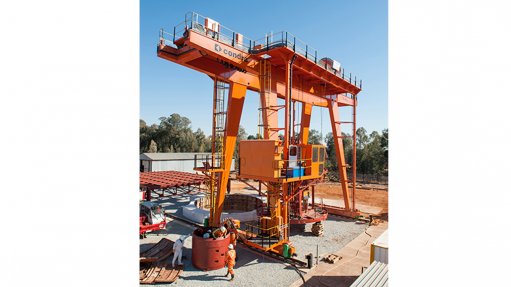
INTELLIGENT LIFTING Condra Cranes has introduced more intelligent solutions on some of its more advanced crane machines
Local crane manufacturer Condra Cranes MD Marc Kleiner stresses that the competitiveness of the local cranes and hoists market has been exacerbated by cheaper imports of cranes, hoists and related components, as well as shortages in raw materials.
Such shortages have been the result of supply chain disruptions, owing to the Covid-19 pandemic, which has also worsened an ongoing local steel shortage.
Providing better engineering solutions and improving response time for maintenance services enable Condra to provide crane and hoist solutions that last longer than imported products, says Kleiner.
This can help customers to save on maintenance cost, as there is less downtime, because they don’t have to wait for components to be imported and for cranes to be serviced.
“Machines or parts take six to eight weeks to be imported, whether from Europe or China, and time costs money. “You don’t have that experience with us, as we have parts available locally. We can have anything ready for customers within 24 to 48 hours, and that’s what we’ve been using to mitigate the impact of cheaper imported solutions.”
Kleiner also highlights that Condra Cranes employs a design team with up to four engineers who can develop contingency solutions, particularly in instances where a customer requests assistance with a specific challenge and requires a t ailor-made crane solution.
For example, to mitigate the shortage of raw materials, such as square steel bars used in the assembly and manufacturing of heavier crane machines, Condra Cranes has been able to use its in-house design team to allow for design adjustments and alternatives.
“We can use the same materials used in local rail infrastructure as a replacement for the square bar in this case; we can change the design and we can manufacture. “Unfortunately, the rail replacement is currently an imported component, rather than a local component. “We’re trying to drive the local market, as the more the local market grows the better for Condra’s business.”
Meanwhile, similar to automotive vehicles that have implemented intelligent solutions in recent years, Condra Cranes has introduced more intelligent solutions – including sensor technology, such as break gap sensors – on some of its more advanced crane machines, Kleiner explains.
“We can also implement technologies such as digital scaling. This enables one to weigh everything that is lifted with a crane hook, and this data can be computer logged and generated into a data system to analyse and keep track of what is lifted.”
He adds that the company is also using variable-speed drives, as well as brake logic circuits that use sensors to inform technicians when brakes are beginning to fail on crane machines and need servicing.
Local Projects
The company will be actively involved in supplying equipment to three significant projects in South Africa and Zimbabwe.
Crane machines and hoist components will be supplied to an iron-ore mining project, in the Northern Cape, and a platinum mine project, in Zimbabwe, while support services will be provided for a construction project in KwaZulu-Natal.
The three projects have a combined project value of about R20-million, and are also expected to be completed before mid-year. The company is also in the tender stage of other projects that will begin later this year, adds Kleiner.
Further, Condra Cranes is focusing on consolidation in the local market.
“We’re also looking to improve our maintenance services and spare parts network in Africa, particularly countries such as Botswana, Namibia, Zambia and the Democratic Republic of the Congo. We’re focusing on being able to consistently provide maintenance and support services for customers within 48 hours, especially with the impact Covid-19 has had on travel.”
The company is also aiming to expand and export more of its cranes and hoist solutions to regions such as North America and Europe.
“Our equipment is rigid and built for robust conditions in Africa, especially in corrosive environments. Companies in the region are used to getting their crane machines from Europe or Asia, but our equipment seems to last longer. “This appeals to engineers in these regions, as this will lead to less maintenance, which can contribute to improving a company’s production and bottom line,” Kleiner concludes.